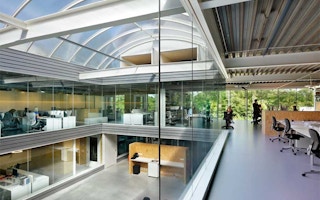Green buildings in Singapore will soon be kinder to not just the environment, but the people working in them.
Launched on the third day of the 2018 International Green Building Conference, the new Green Mark for Healthier Workplaces scheme seeks to cultivate healthier indoor environments that promote employees’ health and well-being in addition to environmental sustainability in the office.
A joint collaboration between the Building and Construction Authority (BCA) and the Health Promotion Board (HPB), the scheme puts forward a strong business case for companies to incorporate designs, policies and programmes that promote occupant health, well-being and comfort.
According to BCA’s chief executive officer, Hugh Lim, a recent study by National University of Singapore revealed that occupants in Green Mark buildings were less likely to fall sick due to better indoor environment quality. Recognising that employees are a company’s biggest asset and that their productivity was paramount, he said that there is now “greater impetus for companies to provide healthier and greener workplaces for [their] well-being.”
Placing health and well-being at the forefront of workplace design also serves to make green and sustainable buildings more appealing and personal to occupants, who benefit from working in a more conducive environment.
The scheme was unveiled at the BCA Breakfast Talk for CEOs, where Minister of State for National Development and Manpower Zaqy Mohamad pointed to the “growing body of research on the impact of interior design on occupant health and well-being.” He added that it made sense to link both objectives of creating environmentally-friendly and healthy office spaces, considering the design of interior spaces had a significant impact on energy use as well.
The new Green Mark scheme is also included in the Green Mark Incentive Scheme for Existing Building and Premises that enables the tenants of small and medium enterprises (SMEs) to receive up to $40,000 in co-funding for energy efficiency improvements to their buildings.
Zee Yoong Kang, chief executive officer of HPB, said: “With employees spending about 60 per cent of their day at work, the workplace is a key touchpoint to support and remind employees to stay healthy.” He added it was essential that more companies prioritise employees’ health by creating a supportive environment in the office and implementing health policies.
One SME setting an example for healthy workplaces is Facility Link, which was one of the ten companies that piloted the scheme and attained Green Mark Platinum status. The company conducts physical activity programmes such as Zumba classes, and encourages its employees to use internal staircases designed to be more appealing to users. ‘No Smoking’ Fridays are also implemented at Facility Link to create a supportive tobacco-free environment.
“
Individual action and user behaviour are crucial in ensuring positive outcomes for green buildings.
Zaqy Mohamad, Minister of State, Ministry of National Development and Manpower
Occupant behaviour to advance sustainability in the workplace
BCA has been placing more emphasis on the role of building occupants in improving the sustainability credentials of green buildings. Other than promoting health and well-being, BCA has sought to cut down the sector’s energy consumption by influencing occupants to practice environmentally-friendly behaviour and limit their energy use in the workplace.
Introduced in 2017, the Behavioural Change Pilot Programme, a collaboration between BCA and the Singapore Green Building Council, focuses on engaging and educating employees on eco-friendly behaviour and actions that they can reproduce at work and at home. Each campaign is customised to suit each company and lasts for about six to 12 months.
The session highlighted the programme’s progress in getting six companies with large business portfolios on board. One of the companies aiming to reduce energy consumption is Swissotel Merchant Court, which has so far managed to achieve 4 per cent in energy savings by adopting more than 30 behavioural changes at work. These changes include operating the washing machines at full load instead of the usual half and taking the stairs instead of the lift.
“There was some inertia at first when we rolled out the campaign as our colleagues were used to a certain way of doing things,” said Rainer Tenius, the company’s general manager. “But after they got through the first step, everyone now understands how they can each contribute to our greater aim of achieving energy savings, without affecting our day to day operations.”
According to Mohamad, the concept of green buildings extends beyond physical infrastructure and technology. He said: “Individual action and user behaviour are crucial in ensuring positive outcomes for green buildings.”
















